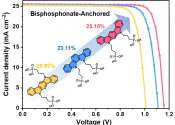A portable instrument to measure indoor air pollution
Most people know air pollution exists outside from cars, trucks and industry, but many are unaware their indoor air quality could be worse than that of a big city.
Mar 23, 2023
0
95
Engineering

Most people know air pollution exists outside from cars, trucks and industry, but many are unaware their indoor air quality could be worse than that of a big city.
Mar 23, 2023
0
95
Energy & Green Tech

Applying a coat of paint on the walls of a house may soon help to heat it, saving energy and reducing CO2 emissions. It could also clean the air that we breathe, breaking down chemicals and pollutants, and eliminating harmful ...
Jan 17, 2020
2
54
Engineering

Passive day cooling is a promising technology for the sustainable reduction of energy consumption. It avoids the heating up of buildings by solar radiation and dissipates accumulated heat without external energy consumption. ...
Jul 18, 2022
0
369
Engineering

Say you notice a sudden drop in temperature on both your patio and kitchen thermometers. At first, you think it's because of a cold snap, so you crank up the heat in your home. Then you realize that while the outside has ...
Feb 16, 2023
0
45
Consumer & Gadgets

Whether it comes from second-hand cigarette smoke, motor vehicle exhaust, building materials or the fumes from household cleaning supplies, toxic air is all around us.
May 8, 2020
0
87
Energy & Green Tech

A research group led by Prof. Ge Ziyi from the Ningbo Institute of Materials Technology and Engineering (NIMTE) of the Chinese Academy of Sciences has developed three isomeric bisphosphonate-anchored self-assembled molecules ...
May 30, 2024
0
50
Engineering

Newly developed flexible, porous and highly sensitive nitrogen dioxide sensors that can be applied to skin and clothing have potential applications in health care, environmental health monitoring and military use, according ...
May 20, 2022
0
128
Electronics & Semiconductors

As silicon-based technology reaches its absolute limits, a material engineered by University of Queensland researchers could herald the next generation of electronics with more memory, faster speeds and advanced features.
Jul 8, 2021
0
16
Electronics & Semiconductors

Proton batteries are an innovative and environmentally friendly type of battery in which charge is carried by protons, which are positively charged hydrogen ions. A team of researchers has now developed organic sulfonamides ...
Apr 22, 2022
0
140
Energy & Green Tech

Both Uber and Lyft ride-hailing services have pledged to fully electrify their vehicle fleets by 2030 in the United States.
Jun 7, 2023
0
52
Nitrogen (pronounced /ˈnaɪtrədʒɨn/) is a chemical element that has the symbol N and atomic number 7 and atomic mass 14.00674 u. Elemental nitrogen is a colorless, odorless, tasteless and mostly inert diatomic gas at standard conditions, constituting 78% by volume of Earth's atmosphere.
Many industrially important compounds, such as ammonia, nitric acid, organic nitrates (propellants and explosives), and cyanides, contain nitrogen. The extremely strong bond in elemental nitrogen dominates nitrogen chemistry, causing difficulty for both organisms and industry in converting the N2 into useful compounds, and releasing large amounts of energy when these compounds burn or decay back into nitrogen gas.
The element nitrogen was discovered by Daniel Rutherford, a Scottish physician, in 1772. Nitrogen occurs in all living organisms. It is a constituent element of amino acids and thus of proteins, and of nucleic acids (DNA and RNA). It resides in the chemical structure of almost all neurotransmitters, and is a defining component of alkaloids, biological molecules produced by many organisms.
This text uses material from Wikipedia, licensed under CC BY-SA